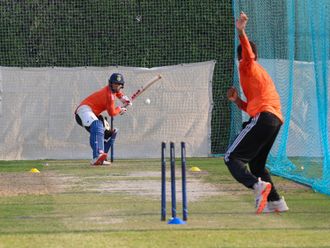
Dubai: England’s battle-scarred warhorse James Anderson has ended his decorated career that spanned 22 years after making his debut in the One Day Internationals in 2002. It’s indeed a remarkable feat considering that he could continue to ply his trade across several continents and different climatic conditions. Despite the wear and tear, the 41-year-old didn’t lose his bite even a bit and finished with a four-wicket haul, way below his best in the longest format, where his best was 11 for 71.
What is the secret behind Anderson’s longevity in international cricket?
Fast bowlers are a protected species in world cricket. There was a time when pacers were not exerting themselves during fielding. Even the skippers don’t push them to chase a ball and tire themselves. But things slowly turned in the 1990s and the turn of the century has not been kind to the speed artists.
The ultra-competitive nature of the One-Day Internationals and the advent of Twenty20 format only made it more difficult for the pacers to thrive. They are not only expected to bowl quick short spells, they have to sprint, slide and stop the extra runs that the opponents are looking for.
Illustrious career
In this contest, England ace Anderson played in all three formats, though a very few in Twenty20. He has played a phenomenal 382 matches, Tests and ODIs in his illustrious career that spanned 22 years. Not an easy task for a fast bowler to have such a long spell and finishing with 704 wickets in 188 Tests, the highest by a fast bowler.
The next one on the list is his fellow Englishman and pace partner Stuart Broad, who has 100 wickets less in 167 Tests.
Anderson has toiled hard to make England one of the dominant forces in world cricket, especially at home and in conditions where there is a bit of assistance to seam and swing.

Anderson, who retired after the first Test against the West Indies at Lord’s on Friday, was a complete pace bowler with conventional swing and seam and could cause trouble with the reverse swing, especially in the subcontinent where the ball becomes rough quite early. Anderson need not exert himself and bend his back to generate great pace. His reliance on swing and seam helped him to ease into his bowling stride, which in turn aided in keeping him relatively injury free through out his career.
Sachin Tendulkar heaps praise
What makes Anderson special? Indian legend Sachin Tendulkar, who has been involved in many a battles with the England pacer, summed it up nicely.
“Here’s a little wish as you bid goodbye. It has been a joy to watch you bowl — with that action, speed, accuracy, swing and fitness. You’ve inspired generations with your game.”
Anderson, who will turn 42 on July 30, was an integral part of three victorious Ashes campaigns. He also became the first England bowler to take 500 Test wickets, to leave Ian Botham’s mark of 383 way behind. With 708 wickets, Jimmy, as he is known to his teammates, is third on all-time highest wicket-takers’ list after finishing four wickets shy of Australian legend Shane Warne.
Anderson’s career also coincided with the advent of England central contracts, which meant he was not required to combine Test duty with playing county cricket, something the previous generation of England fast bowlers had to deal with.
For example, England fast-bowling great Fred Trueman — the first man to take 300 Test wickets — averaged 21.57 runs per wicket in his 67 Tests, while also bowling thousands of overs for Yorkshire, at a time in the 1950s and 1960s when there were only six nations competing in the five-day game compared to today’s 12. Anderson averaged 26.45, with nothing like the same workload at Lancashire.
800 - Muttiah Muralitharan (Sri Lanka), 133 matches, average 22.72
708 - Shane Warne (Australia), 145, 25.41
704 - James Anderson (England), 188, 26.45
619 - Anil Kumble (India), 132, 29.65
604 - Stuart Broad (England), 167, 27.68
563 - Glenn McGrath (Australia), 124, 21.64
530 - Nathan Lyon (Australia), 129, 30.28
519 - Courtney Walsh (West Indies), 132, 24.44
516 - Ravichandran Ashwin (India), 100, 23.75
439 - Dale Steyn (South Africa), 93, 22.95
Anderson had his share of injuries over the years and the England pacer firmly believed that fast bowlers have to strike a right balance in spending time at the gym and nets.
Lesson for aspiring pace bowlers
“It’s all about finding the right balance. It’s difficult for bowlers to play all three formats with the amount of international cricket going on at the moment and the amount of franchise cricket to add to that,” Anderson told Gulf News during his visit earlier. ”For me, it is to find the balance at what you do at the nets. I know that gym sessions have become more important and guys are spending more time at the gym than they are used to do before. It is still important to find your roles in the nets.”
The time he bowled at the nets allowed him to continue playing at the highest level for so many years, a lesson for all aspiring pace bowlers in this modern era.
Anderson is a team man any captain would love to have in his team. The pacer makes it easier by targeting the best in rival camp. He dismissed Brian Lara in the left-hander’s last innings in at the Oval. The West Indian, whose 400 not out is still the highest individual score in Tests, told BBC Breakfast that it was the best delivery he had faced.
In the current crop, Anderson has dismissed Indian talisman Virat Kohli seven times, while he had ended the innings of Tendulkar nine times in 14 games and Australian opener David Warner on 10 occasions.

How he manages to achieve that?
“I don’t enjoy bowling to anyone. They are the best,” he had told in jest. But the steely resolve behind that smiling, lean appearance helped him to meticulously plan their downfall. “T20 has made it difficult for bowlers as the standard of batting has gone up. People play all formats of the game and have a good technique and big-hitting ability. I don’t think it has made any easier.”
The team man
Anderson paid glowing tributes to Tendulkar, calling the Indian Master Blaster “the best batter”
“The best batter, I would have to say is Sachin Tendulkar. I don’t remember having a specific game plan against Sachin Tendulkar. Once he came on, I would just think that I cannot bowl a bad ball here, he was that kind of player.
“He was a key for India as well. If you get him out in India, the whole atmosphere, in the ground changes. He was such a big wicket,” Anderson told Sky Sports after his last Test.
Anderson’s skipper Ben Stokes gave the real perspective about the team man.
“He’s someone who loves to see other people do well. I’m sure he’d have loved to have that fairytale ending that Broady got last year but, for him, seeing a young lad come in and take 12 wickets on debut, he’d have really enjoyed that as well. He’s a great player, a great person and a great man,” Stokes said.
Anderson might have bowled his last spell, but he is getting ready to start a new one, as the mentor.












